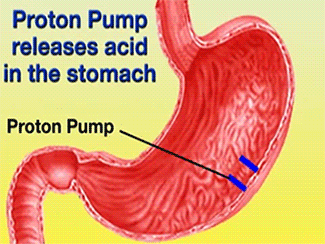User:Alisha, Deepa, Pamiz/Sandbox 1
From Proteopedia
Contents |
Introduction
Image:Esomeprazole2d.png
2D structure of Esomeprazole Esomeprazole has two important pyridine and benzimidazole moieties linked through a methylenesulfinyl group.
Image:Etable.jpg
Biochemical Parameters of Esomeprazole pKa, IC50, AUC Cmax, and half life values of Esomeprazole.
H+/K+-ATPase
The H+/K+-ATPase pump is part of the P-type ATPase family located within the cytoplasmic membrane of resting parietal cells (Figure 1); powered through ATP hydrolysis, the ATPase is translocated to the canalicular membrane and begins to pump cytoplasmic H+ into the canalicular space, in exchange for extracellular K+ ions. It is a pro-drug that is protonated twice in the acidic environment of the parietal cell to form the active inhibitor, sulfenamide which forms disulfide bonds with Cys 813 and Cys 892 on the α subunit of the H+/K+-ATPase.3 Targeting this enzyme using PPIs is the most effective therapeutic control agent of gastric acid secretion.3 Esomeprazole is an α,β-heterodimeric enzyme, where the catalytic site is present in the α subunit (Figure 2).7 Transmembrane segments TM4, TM5, TM6, and TM8, are located in the α subunit and contain the ion binding region of the enzyme.7 Binding of ions and ATP to these domains will induce movements in the membrane domain that catalyze ion displacement.7Conformational Change and Signaling Pathway of H+/K+-ATPase
Inorganic Pi produced from the hydrolysis of ATP drives a conformational change in the enzyme and allows release of H+ into the highly acidic environment.5 The enzyme catalyzes this reaction by changing conformation states between E1 and E2 (Scheme 1).6Image:E1 to e2.jpg
The reaction begins when a hydronium ion binds to the enzyme on the cytoplasmic surface.6 MgATP will phosphorylate the enzyme at an Asp386 residue in a DKTG amino acid sequence to form the E1~Pi H+ intermediate.6 E1 undergoes a conformational change to form E2, where the ion site is exposed and H+ is released at a pH ~ 1.0.7 Extracellular K+ ions then bind to the same exposed region and the enzyme dephosphorylates.7 An occluded form of the enzyme (trapped) is formed once K+ ions bind; the enzyme de-occludes, reforms the E1 complex, and K+ is released.7
Image:Pump.jpg
H+/K+-ATPase pump The signals (acetylcholine, histamine, and gastrin) activate the pump in order for the vesicles to move toward the lumen of the stomach.9 These signals bind to their corresponding receptors and activate the cAMP dependent pathway and the Ca2+ dependent pathway.9 Increased levels of intracellular Ca2+ and cAMP will promote the translocation of vesicles to the canalicular membrane, activating the H+/K+-ATPase.9 Histamine binds to a receptor (Histamine H2), and sends a signal through a G protein which activates adenylate cyclase, and catalyzes the conversion of ATP to cAMP.9 Gastrin will stimulate the release of histamine by binding to the gastrin receptor (CCK2).9 Acetylcholine binds to a receptor (Muscarinic M3) and releases Ca2+ from the endoplasmic reticulum.9
Esomeprazole Mechanism
Esomeprazole is protonated twice within the acidic environment, and forms the active inhibitor—achiral sulfenamide at pKa of 1 (Scheme 2).11Image:Esomeprazole Mechanism.jpg
Activation of Esomeprazole to sulfenamide7. R1=OCH3, R2=CH3, R3=CH3, R4=CH3, X=CH, Bz=benzimidazole, Py=pyridine.7 Mechanism: (1) protonation of Py, (2) protonation of Bz, (3) intramolecular rearrangement of BzH+-Py, forms sulfenic acid (4) dehydration to form sulfenamide (5) disulfide bond formation between enzyme Cys residues and sulfenamide.
Drug-Molecule Interaction
The interaction between Esomeprazole and H+/K+-ATPase has not yet been crystallized.15 Data obtained from the crystallized structure of a SCH28080-ATPase provides structural and binding site information.16 SCH28080 is a competitive K+ inhibitor that interacts with the enzyme’s Phe126 residue and prevents disulfide bond formation between Omeprazole and Cys813, suggesting mutually exclusive inhibitions and an overlapping binding site.16 The crystallized structure of SCH28080-ATPase shows the same luminal-open (E2) conformation as Esomeprazole, and is the first and only crystallized evidence of PPI-ATPase binding site and conformational change.16 Using this information, the SCH28080-ATPase crystallized structure provides evidence of the two binding sites, Cys813 and Cys892.15,16Image:Pymol.jpg
Crystalized Structure of H+/K+-ATPase TM helices 5,6,7,8 are each highlighted in a different color; the majority of the A & B domain within the enzyme, non-catalytic portions of the enzyme, and SCH28080 have been omitted for clarity. The figure depicts the proposed binding sites of the crystallized structure of H+/K+-ATPase. Cys813 and Cys892 are highlighted as the two disulfide bond formation sites. Cys 813 is found between TM5 and TM6 domains while Cys892 is between TM7 and TM8 domains.14 Sulfenamide will interact with these two residues and form disulfide bonds.
Image:Pymol 2.jpg
Binding pocket of SCH28080-ATPase complex PDB image obtained from the RCSB Protein Data Bank.15 Image created using PyMol™ Molecular Graphics System. Majority of the TM domains, non-catalytic portions of the enzyme, and SCH28080 have been omitted. Glu936 (orange), Glu822 (orange), Lys791 (yellow), Glu 795 (orange), Phe126 (gray), Cys892 (light blue), and Cys813 (light blue) are proposed to be part of Esomeprazole’s binding cavity.15,16
Image:2xzb bio r 250.jpg
Pig Gastric H,K-ATPase with bound BeF and SCH28080
![] Cartoon representation of Parietal Cell Image courtesy of ...](/wiki/images/thumb/e/e8/Cell.jpg/300px-Cell.jpg)

